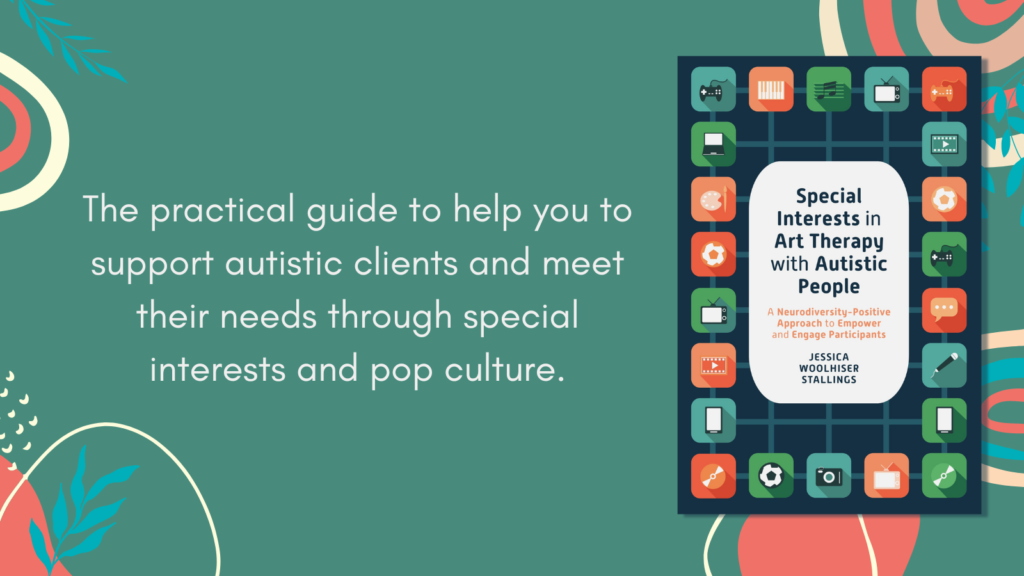In this blog, written by Jessica Woolhiser Stallings the author of Special Interests in Art Therapy with Autistic People, she shares about her own ADHD diagnosis and her work with neurodivergent folk.

I have spent much of my life and career working with and caring for neurodivergent folks. In the 1980s, my parents were told that my brother’s brain was just “wired differently” but that he figured things out. With support and encouragement, he completed his education through a master’s degree, and he now job coaches other neurodivergent folks. As an adult I have worked with kids with diagnoses such as ADHD, autism, anxiety, depression, and many others. I literally wrote the book on providing neurodiversity positive art therapy with autistic folks.
It took decades and all of this for me to step back and acknowledge my own neurodivergence. As a woman with ADHD, I have worked my whole life to mask and compensate for my “different’ brain leading to lifelong anxiety. I am amazingly disorganized despite continual efforts to do better, I have challenges maintaining focus – I never finish reading books (expect for anything Hunger Games), I absent mindedly lose my keys and my work badge multiple times a week, I anxiously postpone completing big tasks until they’re almost due (just ask my doctoral advisor).
I am better able to focus if I can fidget, doodle or engage in stimming (such as shaking my leg or rubbing my fingers together). I also have incredible strengths! Generally, I am great in crisis situations, maybe because my anxiety has me always planning for them.
I am creative, I am empathetic, I am a great child therapist to kids who many people write off as too aggressive or broken. I love to learn and have three advanced degrees. I specialize in use of special interests, intense areas of focus for neurodivergent folks such as video games or anime, in therapy. Ironically, one of my special interests is the special interests of others!
Through my work as a clinician and my personal experience, I know the importance of neurodiversity positive therapy and resources. Working from strengths based and trauma informed perspectives is incredibly important with neurodivergent clients and isn’t always considered in some traditional modes of therapy focused on neurodivergent folks, especially those with Autism.
Moreover, we as a society must shift the burden off of neurodivergent folks to act “typical”. How can we meet them in the middle instead of expecting them to come all the way to the “typical” side of the human spectrum? In celebrating neurodiversity this week, I encourage everyone to examine how they can be more open and accepting and help to encourage that acceptance in others.
In my experience a great place to start is by exploring Special Interests with those in your life. For neurodivergent folks, we often see these as intense interests that can interfere with functioning. However, we can reframe this these interests are a great way to get to know someone and build relationships.
Special interests really serve as a form of a communication- they tell us what a person likes, what is important to them, sometimes they even help us to understand a person’s concerns or fears. Honestly, we all, neurodivergent or not, have something we really like, whether it be superhero movies or sock monkeys or rewatching a “comfort” show (you might have guessed these are some of mine). Inviting the sharing of these interests truly provides opportunities for building and strengthening of relationships.
In my research and in my book, I found that in art therapy these interests often serve one or more of the following 6 functions:
1) Behavioral reward (earning something for a task- like if you try out the art supplies, we will watch your favorite YouTube video)
2) Social initiator (sharing of interests builds rapport for the therapeutic relationship)
3) Social facilitator (creating art featuring special interests that also addresses therapy goals/topics that are less motivating or more difficult to talk about, for instance what if Sonic had a fight with Shadow)
4) Personal metaphor (turning characters/other interests into metaphors for the self or aspects in artwork)
5) Communication clarifier (using examples from special interests toexplain or illustrate concepts)
Although the Special Interest Connection Theory (SICT) was created in the context of providing clinical art therapy, these 6 themes can be a part of any relationship.
As an art therapist, I find exploring these interests through artistic engagement and expression to be particularly helpful. This can come in many forms such as visual art, music (listening or playing), drama (watching or participating), creation of video content for online platforms, and the list could go on. In my current work with children at a therapeutic school, I have found watching Anime and creating art about it to be an incredible tool for group therapy. Anime provides epic and entertaining moral and ethical issues and often includes learning of emotional regulation and navigating relationships. This is so much more relatable to my clients than just listening to me talk.
Some easy, entry level ways to start to engage in art-based sharing of interests might include:
1) Getting a coloring book featuring a special interest and using it together
2) Sharing favorite songs, videos, video games or shows with each other.
3) Creating your own videos sharing your special interests with others
4) Making art together- such as original drawings, about special interest
These don’t have to be clinical level interactions. However, if you are a therapist who wants to integrate these things clinically there are many more examples of how to do so in my book Special interests in art therapy with autistic people: A neurodiversity-positive approach to empower and engage participants.